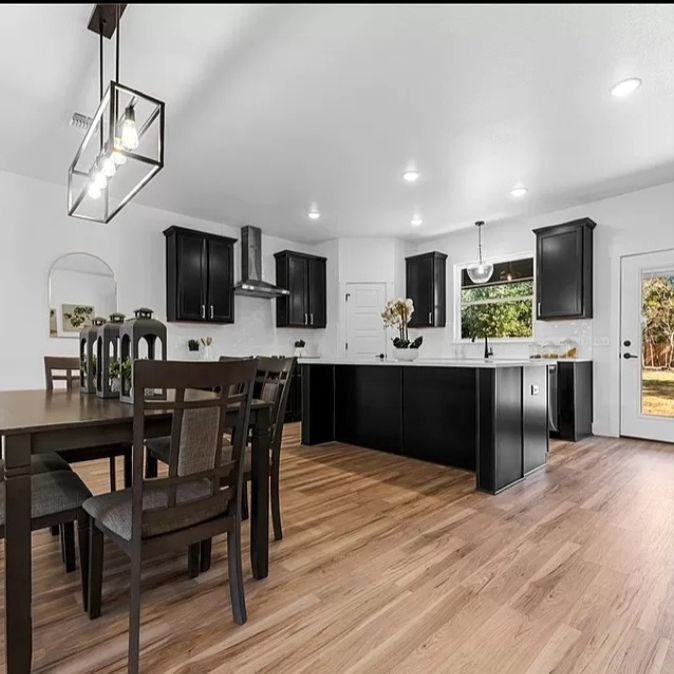Our Blog

By Michael Minguito
•
August 24, 2024
Undergoing a major remodel can be both exciting and daunting. Whether you're renovating your kitchen, adding an extension, or giving your entire home a facelift, the process often comes with a mix of anticipation and stress. Maintaining your home during this period is crucial to ensure that your living space remains functional, safe, and as comfortable as possible. Here's a comprehensive guide on how to maintain your home during a major remodel. 1. Plan Ahead Planning is the cornerstone of a successful home remodel. Before the first hammer swings, make sure you have a clear understanding of the scope of the project. Discuss timelines with your contractor, and ask for a detailed schedule. This will help you anticipate which parts of your home will be affected and when. Key considerations: Create a budget: Outline all potential expenses, including unexpected costs. Designate a living area: Decide which parts of your home will remain functional during the remodel. Pack and store: Identify items that need to be packed away to protect them from dust and damage. Plan for noise: Consider how you’ll handle the noise, especially if you’re working from home or have young children. 2. Set Up a Temporary Kitchen If your kitchen is the focus of your remodel, setting up a temporary kitchen is essential. This makeshift space doesn’t have to be elaborate, but it should be functional enough to meet your basic needs. Essentials for a temporary kitchen: Microwave: A microwave is a must for reheating meals. Portable cooktop: Consider a portable induction or electric cooktop for basic cooking. Mini-fridge: A small refrigerator will keep perishables fresh. Prep space: Use a table or countertop for meal preparation. Storage: Plastic bins can store non-perishable food, utensils, and other kitchen essentials. 3. Protect Your Belongings During a remodel, your belongings can be vulnerable to dust, debris, and potential damage. Protecting your possessions is a key part of maintaining your home’s integrity. Tips to protect your belongings: Use plastic sheeting: Cover furniture, electronics, and other valuable items with plastic sheeting to protect them from dust. Move items: If possible, relocate valuable or fragile items to a safe area away from the construction zone. Seal off rooms: Use plastic barriers with zippers to seal off rooms that are not part of the remodel. Utilize storage: Consider renting a storage unit for larger items or for belongings you won’t need until the remodel is complete. 4. Maintain Cleanliness Keeping your home clean during a remodel can be challenging, but it’s not impossible. Regular cleaning will help minimize dust and debris, keeping your living space more comfortable. Cleaning strategies: Daily cleaning: Allocate time each day to sweep and vacuum the areas adjacent to the construction zone. Air filtration: Invest in air purifiers to help remove dust particles from the air. Dust mats: Place dust mats at the entrances to construction areas to catch debris from workers’ shoes. Waste management: Ensure there is a designated area for construction waste, and that it is removed regularly. 5. Ensure Safety Safety should be a top priority during a remodel. Construction zones can be hazardous, especially if you have children or pets. Safety tips: Secure the site: Ensure that the construction area is securely sealed off from the rest of the home. Communication: Talk to your contractor about safety protocols and emergency procedures. Childproofing: If you have young children, install safety gates and keep them away from the construction zone. Pet safety: Keep pets in a safe area of the house, away from noise and dust. Consider boarding them temporarily if necessary. 6. Stay Organized Remodeling can easily lead to chaos if you’re not organized. Keeping things in order will help you maintain some sense of normalcy during the process. Organizational tips: Use a calendar: Track the progress of the remodel and note important milestones or deadlines. Label boxes: Clearly label any boxes or bins you use to store belongings during the remodel. Create a daily routine: Establish a daily routine that accommodates the remodel, ensuring you can still meet your day-to-day needs. Communicate regularly: Stay in close contact with your contractor to discuss progress, concerns, and changes to the schedule. 7. Manage Your Expectations A remodel can be an emotional rollercoaster, with excitement often giving way to frustration as the project progresses. Managing your expectations will help you navigate these ups and downs. Tips for managing expectations: Expect delays: Understand that delays are common in remodeling projects. Weather, supply chain issues, and unexpected problems can all cause setbacks. Be flexible: Be prepared to adjust your plans as needed. Whether it’s a change in the design or a delay in the timeline, flexibility is key. Focus on the outcome: Keep the end goal in mind. The inconveniences you face now will be worth it when you’re enjoying your newly remodeled home. 8. Consider Temporary Housing If your remodel is extensive, it may be worth considering temporary housing. Living away from the construction zone can reduce stress and allow the work to proceed more quickly. Temporary housing options: Rent a short-term apartment: Some companies specialize in short-term rentals, ideal for families undergoing major remodels. Stay with friends or family: If possible, stay with friends or family during the most disruptive phases of the remodel. Vacation rentals: Sites like Airbnb offer a variety of options for temporary housing, often with flexible terms. 9. Keep Lines of Communication Open Communication with your contractor is crucial throughout the remodel. Regular updates will help you stay informed and address any issues as they arise. Effective communication strategies: Set up regular meetings: Schedule regular check-ins with your contractor to discuss progress and any concerns. Be clear about your expectations: Make sure your contractor understands your vision and your priorities. Ask questions: Don’t hesitate to ask questions if something isn’t clear. It’s better to address concerns early on rather than wait until it’s too late. Document everything: Keep a record of all communications, including emails and text messages, in case any disputes arise. 10. Plan for the Unexpected Even with the best planning, unexpected issues can arise during a remodel. Whether it’s discovering mold behind a wall or realizing that a custom order is delayed, being prepared for the unexpected will help you handle these challenges more effectively. How to plan for the unexpected: Build a contingency fund: Set aside 10-20% of your budget for unforeseen expenses. Stay flexible: Be open to alternative solutions if something doesn’t go as planned. Keep a positive attitude: Unexpected issues can be frustrating, but maintaining a positive attitude will help you navigate these challenges more easily. 11. Stay Involved While it’s important to trust your contractor, staying involved in the process will help ensure that the remodel meets your expectations. Ways to stay involved: Visit the site regularly: Make it a habit to visit the construction site regularly to see the progress firsthand. Ask for updates: Request regular updates from your contractor and ask for photos if you can’t visit the site. Review work: Take the time to review completed work and address any concerns immediately. Stay informed: Keep up with the latest trends and materials in home remodeling to ensure you’re making informed decisions. 12. Celebrate Milestones Finally, don’t forget to celebrate the milestones along the way. Remodeling can be a long and challenging process, so taking time to celebrate progress can keep morale high. Milestone celebrations: Completion of demolition: Once the old is out, celebrate the start of the new. Framing: When the skeleton of your new space is up, take a moment to appreciate how far you’ve come. Halfway point: Mark the halfway point with a small celebration or treat for the family. Final touches: Celebrate the installation of final elements like cabinetry or flooring. Project completion: When the remodel is complete, host a small gathering to show off your new space and celebrate the journey. Conclusion Maintaining your home during a major remodel requires careful planning, organization, and flexibility. By following the tips outlined in this guide, you can minimize disruption, protect your belongings, and keep your home as functional and comfortable as possible during the remodeling process. Remember, while the journey may be challenging, the end result—a beautifully remodeled home—is well worth the effort.

By Michael Minguito
•
August 24, 2024
Embarking on a major home remodel is an exciting but challenging endeavor. Whether you're looking to modernize your kitchen, add an extra room, or completely overhaul your living space, a successful remodel requires careful planning and a well-structured budget. This guide will walk you through the steps to plan and budget for a major home remodel, ensuring that you achieve your vision without breaking the bank. 1. Define Your Goals and Vision Before you begin any remodeling project, it's essential to clearly define what you want to achieve. Consider the following questions: What specific areas of your home do you want to remodel? What are your priorities (e.g., increasing space, improving functionality, enhancing aesthetics)? What style or design do you envision for the remodeled space? Creating a detailed list of your goals and a vision board with images that inspire you can help keep your project on track and provide a reference point for decisions later on. 2. Assess Your Current Space Once you've defined your goals, take a close look at your current space. Evaluate its strengths and weaknesses, and determine what needs to change to meet your goals. This assessment will help you identify any structural issues that need to be addressed, such as plumbing, electrical work, or foundational repairs, which can significantly impact your budget. 3. Set a Realistic Budget Setting a realistic budget is one of the most critical steps in planning a major home remodel. Your budget should include all costs associated with the project, from materials and labor to permits and unexpected expenses. Here's how to create a comprehensive budget: a. Research Costs Start by researching the average costs for the type of remodel you want to undertake. You can find cost estimates online or consult with contractors to get a rough idea of what to expect. Keep in mind that prices can vary significantly depending on your location, the scope of the project, and the quality of materials you choose. b. Get Multiple Quotes When you've narrowed down your project scope, reach out to several contractors to get detailed quotes. Ensure that the quotes include a breakdown of costs for materials, labor, permits, and any additional fees. Comparing multiple quotes will give you a better understanding of the price range and help you choose a contractor who fits your budget. c. Prioritize Your Spending Once you have an idea of the overall cost, prioritize your spending. Decide which aspects of the remodel are most important to you and allocate your budget accordingly. For example, if high-quality countertops are a priority, you may need to compromise on other areas, such as cabinetry or flooring. d. Set Aside a Contingency Fund Unexpected expenses are almost inevitable in any major home remodel. To avoid financial stress, set aside a contingency fund of 10-20% of your total budget. This fund will cover any unforeseen costs, such as structural issues or changes in material prices, that may arise during the project. 4. Plan the Timeline A well-planned timeline is essential for keeping your remodel on track and within budget. Here's how to create an effective timeline: a. Determine the Project Duration The duration of your remodel will depend on the scope of the project and the availability of contractors. Discuss the estimated timeline with your contractor and ensure that it aligns with your expectations. Be realistic about how long each phase of the project will take, and allow for potential delays. b. Plan for Temporary Disruptions Major home remodels can be disruptive to your daily life. Depending on the extent of the work, you may need to find temporary accommodations or make arrangements for alternate living spaces. Consider these disruptions when planning your timeline and budget. c. Schedule Key Milestones Break down the project into key milestones, such as demolition, framing, plumbing, electrical work, and finishing touches. Scheduling these milestones will help you track progress and ensure that the project stays on schedule. 5. Hire the Right Professionals Choosing the right professionals is crucial to the success of your remodel. Here's how to find and hire the best team for your project: a. Research and Vet Contractors Start by researching contractors who specialize in the type of remodel you want to undertake. Look for reviews, check references, and ask for examples of previous work. It's essential to hire licensed, insured, and experienced contractors who have a proven track record of delivering quality work. b. Interview Multiple Contractors Once you've shortlisted potential contractors, schedule interviews to discuss your project in detail. Ask about their experience, availability, and approach to problem-solving. A face-to-face meeting will give you a better sense of whether the contractor is a good fit for your project. c. Check Credentials and References Before making a final decision, verify the contractor's credentials, including licenses, insurance, and any certifications. Additionally, ask for references from previous clients and follow up to ensure that the contractor has a history of delivering satisfactory results. d. Understand the Contract Once you've selected a contractor, review the contract carefully. Ensure that it includes a detailed scope of work, payment schedule, timeline, and any warranties or guarantees. Clarify any ambiguous terms before signing to avoid misunderstandings later on. 6. Choose Materials Wisely The materials you choose for your remodel will significantly impact both the cost and the final outcome. Here's how to make informed decisions about materials: a. Balance Quality and Cost While it's tempting to go for the highest-end materials, it's essential to balance quality with cost. Consider where you can save without compromising on durability or aesthetics. For example, you might choose a more affordable countertop material that mimics the look of expensive stone or opt for mid-range fixtures that offer good value for money. b. Source Materials Early To avoid delays and cost increases, source your materials early in the planning process. Ordering materials well in advance gives you time to compare prices, take advantage of sales, and ensure that everything arrives on time. c. Consider Sustainable Options Sustainable materials are not only better for the environment but can also add value to your home. Consider using recycled or eco-friendly materials, energy-efficient appliances, and water-saving fixtures. While these options may have a higher upfront cost, they can lead to long-term savings on utility bills and increase the resale value of your home. 7. Obtain Necessary Permits Depending on the scope of your remodel, you may need to obtain permits from your local building authority. Failing to secure the necessary permits can lead to fines, delays, and complications when selling your home. Here's what you need to know: a. Understand Permit Requirements Consult with your contractor or local building authority to determine which permits are required for your project. Common permits include those for structural changes, electrical work, plumbing, and additions. Make sure to factor permit costs into your budget. b. Submit Permit Applications Early Permit approval can take time, so submit your applications as early as possible. Delays in obtaining permits can hold up your project and increase costs if contractors are unable to proceed with the work. c. Schedule Inspections Once your permits are approved, you'll need to schedule inspections at various stages of the remodel. Inspections ensure that the work complies with local building codes and is safe for occupancy. Coordinate with your contractor to schedule inspections in a way that minimizes disruptions to the project timeline. 8. Monitor Progress and Stay Involved Even if you've hired a trusted contractor, it's essential to stay involved throughout the remodeling process. Regular communication and oversight can help prevent costly mistakes and ensure that the project stays on track. Here's how to stay involved: a. Schedule Regular Check-Ins Set up regular meetings with your contractor to review progress, address any concerns, and make decisions as needed. These check-ins will help you stay informed and allow you to catch any issues before they become major problems. b. Be Prepared for Decision-Making During the remodel, you'll need to make decisions about materials, finishes, and design details. Stay organized by keeping all project-related documents, samples, and notes in one place. Being prepared will help you make informed decisions quickly, preventing delays. c. Track Expenses Keep a close eye on your budget by tracking expenses throughout the project. Compare actual costs to your budgeted amounts and address any discrepancies immediately. If costs start to exceed your budget, discuss options with your contractor to bring the project back in line. 9. Finalize and Enjoy Your New Space As your remodel nears completion, there are a few final steps to ensure everything is finished to your satisfaction: a. Conduct a Final Walkthrough Before making the final payment, conduct a thorough walkthrough with your contractor to ensure that all work has been completed according to the contract. Check for any issues, such as unfinished details, poor workmanship, or missing items, and make a list of any necessary corrections. b. Obtain Final Approvals and Documentation Ensure that all permits have been closed out, and that you've received any warranties or guarantees for materials and workmanship. Keep these documents in a safe place for future reference. c. Plan for Maintenance To keep your newly remodeled space looking and functioning its best, create a maintenance plan. Regular upkeep, such as cleaning, sealing, and minor repairs, will help protect your investment and prolong the life of your remodel. d. Enjoy Your New Space After months of planning, budgeting, and hard work, it's time to enjoy your newly remodeled home. Whether you've created a more functional kitchen, a luxurious bathroom, or a spacious living area, take pride in your accomplishment and the transformation of your space. Conclusion Planning and budgeting for a major home remodel can be a complex process, but with careful preparation, clear goals, and the right team, you can achieve your dream home without unnecessary stress or financial strain. By following the steps outlined in this guide, you'll be well-equipped to navigate the challenges of a remodel and create a space that meets your needs and reflects your personal style.

By Michael Minguito
•
August 23, 2024
When considering home remodeling, one of the most pressing questions homeowners face is whether the investment will be worth it. Not all remodels offer the same return on investment (ROI), and understanding which projects yield the best value can help you make informed decisions. Here, we explore various home remodeling projects, weighing their costs against their potential value to help you determine what’s worth your money and time. 1. Kitchen Remodeling: The Heart of the Home The kitchen is often considered the heart of the home, and for a good reason. It’s where families gather, meals are prepared, and memories are made. As a result, a well-executed kitchen remodel can significantly increase your home’s value. Cost: A mid-range kitchen remodel can cost anywhere between $25,000 and $50,000, depending on the scope. This includes new cabinetry, countertops, appliances, and flooring. Value: According to the Remodeling 2023 Cost vs. Value report, a minor kitchen remodel offers an average ROI of about 72%. This means that if you spend $25,000 on a kitchen upgrade, you could expect to recoup around $18,000 upon resale. Conclusion: A kitchen remodel is often worth the investment, especially if the current kitchen is outdated. Focus on upgrades that are both functional and aesthetically pleasing, such as energy-efficient appliances and modern finishes. 2. Bathroom Remodeling: A Functional Update Bathrooms are another crucial area where homeowners can see a good return on their investment. Updating an outdated bathroom not only enhances comfort but also improves the overall appeal of your home. Cost: A mid-range bathroom remodel can cost between $10,000 and $30,000, depending on the materials and fixtures used. Value: The same Cost vs. Value report estimates that a mid-range bathroom remodel has an ROI of about 60%. While this is lower than a kitchen remodel, it’s still a significant return. If you spend $20,000, you might expect to get back about $12,000 when you sell your home. Conclusion: Bathroom remodels are worth considering, particularly if your bathroom is in dire need of an upgrade. Prioritize features that improve functionality, such as new fixtures, storage solutions, and updated plumbing. 3. Attic Insulation: A Small Change with Big Returns Adding insulation to your attic is one of the most cost-effective improvements you can make. It might not have the visual impact of a new kitchen or bathroom, but it can significantly reduce energy costs, making your home more comfortable year-round. Cost: The cost to insulate an attic typically ranges between $1,500 and $3,000, depending on the size of the attic and the type of insulation used. Value: Attic insulation has one of the highest ROIs of any home improvement, often exceeding 100%. This means that you could recoup your entire investment and then some. The Cost vs. Value report shows that homeowners can expect an ROI of about 107% for attic insulation. Conclusion: If your attic is under-insulated, this is a no-brainer investment. It’s an affordable upgrade that pays off both in immediate savings on energy bills and increased home value. 4. Window Replacement: Enhancing Energy Efficiency and Curb Appeal Replacing old windows is another project that offers both aesthetic and functional benefits. New windows can improve your home’s energy efficiency, reduce outside noise, and enhance its curb appeal. Cost: Replacing windows in an average home can cost between $8,000 and $20,000, depending on the number and type of windows. Value: The ROI for window replacement is typically around 68% for vinyl windows and 70% for wood windows. This means that for a $15,000 investment, you could recoup about $10,000 at resale. Conclusion: While window replacement isn’t the most lucrative in terms of ROI, it’s a worthwhile investment, especially if your current windows are drafty or outdated. The energy savings and improved comfort can make a significant difference in your day-to-day living. 5. Deck Addition: Outdoor Living Space Adding a deck to your home is a popular way to expand your living space outdoors. Whether you’re hosting a summer barbecue or simply enjoying a quiet evening, a deck can enhance your home’s appeal. Cost: A wood deck addition typically costs between $12,000 and $25,000, while composite decks can cost upwards of $30,000. Value: A wood deck addition has an average ROI of about 65%, while a composite deck offers slightly less at around 63%. For a $15,000 wood deck, you might expect to recover about $9,750 when selling your home. Conclusion: Deck additions can be a valuable investment, particularly in areas with a mild climate where outdoor living is highly desirable. Focus on durable materials and a design that complements your home’s style. 6. Basement Remodeling: Maximizing Usable Space Finishing or remodeling your basement is an excellent way to increase your home’s usable square footage. A well-designed basement can serve as a family room, home office, or even a rental space. Cost: Basement remodeling costs can vary widely, from $20,000 to $70,000 or more, depending on the scope of the project. Value: The ROI for basement remodeling is typically around 70%. If you invest $50,000, you could see a return of about $35,000 at resale. Conclusion: Basement remodeling can be a smart investment, especially if you have an unfinished or underutilized space. The key is to create a functional, attractive area that adds real value to your home. 7. Curb Appeal Improvements: First Impressions Matter Curb appeal is crucial when it comes to selling your home. Simple improvements like landscaping, a new front door, or a fresh coat of paint can make a big difference. Cost: The cost of curb appeal improvements can range from a few hundred dollars for minor landscaping to several thousand for more extensive work like a new driveway or siding. Value: Curb appeal projects often have a high ROI. For example, a new steel entry door can offer an ROI of around 74%, and a garage door replacement can have an ROI of up to 97%. Conclusion: Curb appeal improvements are generally worth the investment, particularly if you’re preparing to sell your home. They’re often relatively low-cost and can have a significant impact on your home’s overall value. 8. Roof Replacement: Protecting Your Investment Your roof is one of the most critical components of your home. If it’s nearing the end of its lifespan, replacing it is essential for protecting your home from the elements. Cost: A roof replacement typically costs between $10,000 and $25,000, depending on the size of your home and the materials used. Value: The ROI for a roof replacement is around 60%, meaning a $20,000 investment might bring back about $12,000 at resale. Conclusion: While a roof replacement may not offer the highest ROI, it’s a necessary expense if your roof is in poor condition. A new roof can also enhance curb appeal and give potential buyers peace of mind. Final Thoughts When deciding which home remodels are worth the investment, it’s essential to balance your personal needs and preferences with the potential ROI. While some projects, like attic insulation and curb appeal improvements, offer high returns, others, like major kitchen or bathroom remodels, may require a more significant upfront investment but still provide substantial value. Ultimately, the best home remodeling projects are those that enhance your quality of life while also increasing your home’s resale value. By carefully considering the cost versus value of each project, you can make informed decisions that benefit both your home and your wallet.

By Michael Minguito
•
August 15, 2024
Home remodeling is more than just a trend; it's a powerful way to transform your living space and improve your quality of life. Whether you're updating your kitchen, adding a new bathroom, or converting an unused room into a home office, remodeling offers numerous benefits that can enhance both the functionality and aesthetic of your home. In this blog post, we'll explore the key reasons why investing in home remodeling is worth it, touching on aspects like increased property value, improved functionality, enhanced comfort, and personal satisfaction. 1. Increased Property Value One of the most compelling reasons to invest in home remodeling is the potential increase in property value. Well-executed remodels can significantly boost your home's resale value, making it more attractive to potential buyers. According to industry experts, certain remodeling projects yield a higher return on investment (ROI) than others. For example, kitchen and bathroom remodels typically offer a substantial ROI, as these are two of the most important areas for homebuyers. Updating outdated features, improving energy efficiency, and enhancing curb appeal can all contribute to a higher property value. In a competitive real estate market, a remodeled home stands out, making it easier to sell and often commanding a higher price. Even if you don’t plan to sell anytime soon, increasing your home’s value can provide financial security and enhance your investment. 2. Improved Functionality Home remodeling allows you to tailor your living space to better meet your needs and preferences. Over time, your lifestyle and family dynamics may change, making it essential to adapt your home accordingly. Remodeling can address issues like insufficient storage, outdated layouts, or inefficient use of space. For instance, adding a kitchen island or expanding a pantry can improve the functionality of your kitchen, making meal preparation and storage more efficient. Converting an unused basement into a functional living area or home office can provide much-needed extra space. By customizing your home to suit your needs, you can enjoy a more comfortable and practical living environment. 3. Enhanced Comfort Your home should be a sanctuary where you feel comfortable and relaxed. Remodeling can enhance your comfort by updating outdated or inefficient systems and incorporating modern conveniences. Upgrading your HVAC system, improving insulation, or installing energy-efficient windows can lead to a more comfortable and energy-efficient home. In addition to functional improvements, remodeling projects can enhance the overall ambiance of your home. New flooring, updated lighting fixtures, and fresh paint can create a more inviting and pleasant atmosphere. Personalized touches, such as built-in shelves or a custom fireplace, can add character and warmth to your space, making it a place you truly enjoy. 4. Increased Energy Efficiency Energy-efficient home improvements are not only beneficial for the environment but also for your wallet. Remodeling offers an opportunity to incorporate energy-saving features that can reduce your utility bills and lower your carbon footprint. Upgrading to energy-efficient appliances, installing low-flow fixtures, and using sustainable materials can make a significant impact. Adding insulation, sealing gaps, and installing energy-efficient windows can help regulate indoor temperatures and reduce heating and cooling costs. By making these updates, you can enjoy long-term savings and contribute to a more sustainable future. 5. Personal Satisfaction There's a unique sense of satisfaction that comes from creating a space that reflects your personal style and preferences. Remodeling allows you to express your creativity and make your home truly yours. Whether it’s designing a custom kitchen, selecting paint colors, or choosing new furniture, the process of remodeling can be incredibly rewarding. Moreover, remodeling provides an opportunity to address issues that have been bothering you, such as outdated fixtures, inefficient layouts, or worn-out materials. By solving these problems, you enhance your daily living experience and create a home environment that aligns with your vision. 6. Improved Safety and Accessibility Remodeling can also enhance the safety and accessibility of your home, which is especially important for families with young children or elderly family members. Upgrading electrical systems, improving lighting, and installing grab bars in bathrooms are just a few examples of how remodeling can address safety concerns. For those with mobility challenges, remodeling can involve adding ramps, widening doorways, or installing stairlifts. These improvements not only make your home safer but also ensure that it remains accessible and functional for all members of the household. 7. Modernization and Aesthetic Appeal Homes, like anything else, can become outdated over time. Remodeling offers a chance to modernize your home and bring it up to current design trends. Modernizing outdated features, such as old-fashioned cabinetry or dated flooring, can refresh the look and feel of your home. Enhancing aesthetic appeal through remodeling can also improve the overall atmosphere of your living space. New design elements, updated fixtures, and contemporary finishes can create a more cohesive and visually pleasing environment. A modern and well-designed home not only enhances your daily living experience but also creates a more enjoyable space for entertaining guests. 8. Customization to Fit Your Lifestyle Every homeowner has unique needs and preferences, and remodeling allows you to customize your home to fit your lifestyle. Whether you're a growing family in need of extra bedrooms, a remote worker requiring a dedicated home office, or an entertainer seeking a stylish and functional space for gatherings, remodeling can address your specific requirements. By tailoring your home to suit your lifestyle, you can maximize its usability and ensure that it meets your needs. This level of customization enhances your overall satisfaction and enjoyment of your living space, making it a more integral part of your daily life. Investing in home remodeling offers a range of benefits that go beyond mere aesthetics. From increasing property value and improving functionality to enhancing comfort and energy efficiency, remodeling provides significant advantages for homeowners. It allows you to create a personalized space that aligns with your needs and preferences, while also offering long-term financial and environmental benefits. If you're considering remodeling your home, weigh the potential benefits against your goals and budget. With thoughtful planning and execution, you can transform your living space into a more functional, comfortable, and stylish environment, making your investment truly worthwhile.

By Michael Minguito
•
August 15, 2024
When it comes to choosing siding for your home, climate plays a pivotal role in determining the best material. Siding not only impacts the aesthetic appeal of your house but also its durability, insulation, and overall energy efficiency. Each climate condition presents its own set of challenges, so understanding these factors can help you make an informed decision. This guide explores the best siding options for various climate conditions, from scorching heat to freezing cold, and everything in between. 1. Understanding Climate Challenges Before diving into specific siding materials, it’s crucial to understand the climate challenges your home might face: Hot and Humid Climates: Areas with high temperatures and humidity levels can cause certain siding materials to warp, crack, or deteriorate quickly. Cold and Snowy Climates: Freezing temperatures, snow, and ice can put stress on siding, leading to issues like cracking or peeling. Coastal and Salt-Air Environments: Coastal areas are exposed to saltwater, which can lead to rusting and corrosion in many siding materials. Rainy and Wet Climates: Excessive moisture and rain can lead to issues such as mold, rot, and peeling. Dry and Arid Climates: Dry climates can cause materials to become brittle and crack under intense sun exposure. 2. Best Siding Options for Hot and Humid Climates Fiber Cement Siding: Fiber cement siding is an excellent choice for hot and humid climates due to its durability and resistance to moisture. It’s made from a blend of cement, sand, and cellulose fibers, which makes it resistant to warping, cracking, and insect damage. Fiber cement also offers good insulation, helping to keep your home cooler in the summer. Vinyl Siding: Vinyl siding is another popular choice for hot and humid climates. It’s lightweight, resistant to moisture, and relatively low-maintenance. Modern vinyl siding also comes in a variety of colors and styles, allowing homeowners to achieve the look they want without compromising on performance. Metal Siding: Aluminum and steel siding are durable options that perform well in hot and humid conditions. Metal siding is resistant to moisture and can withstand high temperatures without warping or cracking. Additionally, metal siding reflects heat, which can help keep your home cooler. 3. Best Siding Options for Cold and Snowy Climates Insulated Vinyl Siding: In cold climates, insulated vinyl siding can provide additional insulation to help keep your home warm. The insulation layer reduces heat loss and prevents cold spots, making it a practical choice for frigid weather. Fiber Cement Siding: Fiber cement siding is also suitable for cold climates due to its resistance to cracking and peeling. It can handle the expansion and contraction that comes with freezing temperatures without losing its integrity. Engineered Wood Siding: Engineered wood siding is treated to resist moisture and temperature fluctuations, making it a viable option for cold climates. It provides good insulation and maintains its appearance even in harsh weather conditions. 4. Best Siding Options for Coastal and Salt-Air Environments Vinyl Siding: Vinyl siding is highly resistant to saltwater and doesn’t rust or corrode. It’s also easy to clean, which is a significant advantage in coastal areas where salt spray can accumulate. Fiber Cement Siding: Fiber cement siding is also a good option for coastal areas. Its composition makes it resistant to moisture and salt, ensuring long-term durability in salty environments. Aluminum Siding: Aluminum siding is resistant to rust and corrosion, making it a suitable choice for coastal areas. However, it’s essential to ensure that it is properly coated to prevent any potential corrosion over time. 5. Best Siding Options for Rainy and Wet Climates Fiber Cement Siding: Due to its moisture resistance, fiber cement siding is an excellent choice for rainy and wet climates. It doesn’t absorb water, preventing issues such as mold and rot. Vinyl Siding: Vinyl siding is also moisture-resistant and can handle heavy rain without warping or peeling. However, proper installation is crucial to prevent water infiltration behind the siding. Metal Siding: Metal siding, especially when properly coated, can withstand heavy rain and prevent moisture-related issues. It’s essential to ensure that the siding is well-sealed and that all joints are properly flashed. 6. Best Siding Options for Dry and Arid Climates Stucco Siding: Stucco is a traditional siding option that works well in dry climates. It’s durable and provides excellent insulation against temperature fluctuations. Stucco also has a natural ability to withstand intense sunlight and heat. Fiber Cement Siding: Fiber cement siding is also suitable for dry climates. It’s resistant to sun damage and won’t crack under intense heat. Its durability ensures that it maintains its appearance and performance over time. Metal Siding: Metal siding can handle the extreme sun exposure typical of dry climates. It reflects heat and doesn’t become brittle, making it a durable option for homes in arid regions. 7. Additional Considerations Maintenance: Some siding materials require more maintenance than others. For example, wood siding needs regular staining or painting, while vinyl and fiber cement require minimal upkeep. Energy Efficiency: Consider how siding materials impact your home’s energy efficiency. Insulated siding options can help reduce heating and cooling costs. Aesthetic Appeal: Choose a siding material that complements your home’s architectural style and personal preferences. Modern siding options come in various styles and colors to match different design tastes. Cost: Factor in both the initial cost and long-term maintenance expenses when choosing siding. While some materials may have a higher upfront cost, their durability and low maintenance requirements may result in cost savings over time. Selecting the right siding for your home involves considering the climate conditions and how different materials will perform under those conditions. Fiber cement, vinyl, metal, and stucco are all strong contenders, each offering unique benefits tailored to specific environmental challenges. By understanding the climate-specific needs and characteristics of each siding material, you can make an informed choice that ensures the longevity, efficiency, and beauty of your home.

By Michael Minguito
•
August 15, 2024
Choosing the right siding color for your home is more than just a matter of personal taste. It’s a decision that can significantly impact your home’s curb appeal and its harmony with the surrounding environment. The best siding color enhances the architectural style of your home, complements its environment, and adds to its overall value. Here’s a comprehensive guide to help you select the perfect siding color for your home’s architecture. 1. Consider Your Home’s Architectural Style The architectural style of your home plays a crucial role in determining the ideal siding color. Each style has distinct characteristics that can be highlighted or complemented with the right color. Traditional Styles (Colonial, Victorian, Georgian): Traditional homes often feature classic and subdued colors. For Colonial and Georgian homes, muted tones like soft grays, classic whites, or elegant blues work well. Victorian homes, with their intricate details, benefit from rich and varied colors, such as deep greens, maroons, or even bold combinations like sage and cream. Craftsman and Arts & Crafts: These styles are known for their natural and earthy aesthetic. Colors like taupe, deep brown, and forest green align with the organic materials used in these homes. Accent colors can be muted, such as soft rust or muted mustard. Modern and Contemporary: Modern homes favor sleek, minimalist designs and often use bold, contrasting colors. Think of dark grays, deep blues, or even stark whites. The focus is on clean lines and simplicity, so choose colors that highlight the architectural elements rather than overwhelm them. Mediterranean and Spanish Revival: These styles are characterized by warm, earthy tones. Rich terracotta, sandy beige, and olive green complement the stucco or tile work typical of Mediterranean homes. For a classic look, try shades of cream or warm beige. 2. Evaluate Your Home’s Surroundings The color of your home should harmonize with its environment. Consider the landscape, nearby structures, and neighborhood aesthetics when choosing a siding color. Natural Surroundings: If your home is surrounded by lush greenery or wooded areas, choose colors that blend with the natural landscape. Earthy tones like moss green or taupe can help your home blend seamlessly into its surroundings. In more arid or desert-like environments, sandy beige, terracotta, or muted ochre can reflect the natural palette. Neighborhood Context: Take note of the colors used on neighboring homes. While you don’t have to match them, it’s important to avoid colors that clash or stand out too starkly. Opt for a color that complements the neighborhood while still reflecting your personal style. Climate Considerations: Lighter colors often work well in warmer climates as they reflect sunlight and help keep the house cooler. In cooler climates, darker colors can absorb heat and might help in maintaining warmth. Consider how color affects heat absorption and reflectivity based on your local climate. 3. Test Samples Before Committing Color can look different depending on the time of day and the angle of the light. Before making a final decision, it’s wise to test samples in various conditions. Sample Boards: Obtain sample boards of your top choices and place them on your home’s exterior. Observe how they look in different lighting conditions throughout the day. Pay attention to how the color interacts with your home’s architectural details and other elements. Digital Tools: Many manufacturers and home improvement websites offer digital tools that let you visualize how different siding colors will look on your home. While these can be helpful, they might not always capture the true color and finish as accurately as physical samples. 4. Consider Long-Term Maintenance Different siding colors and materials have varying maintenance needs. Darker colors, for example, may show dirt and wear more readily than lighter colors. Be aware of how often you might need to clean or repaint your siding. Durability: Choose a color that will age gracefully. Lighter colors often hide dirt and weathering better than dark colors. However, dark colors may offer a more dramatic look and can be less prone to showing minor damage. Material Compatibility: Certain materials, like vinyl or fiber cement, have different color options and durability. Ensure that the color you choose is compatible with the siding material and will not require excessive upkeep. 5. Seek Professional Advice If you’re uncertain about making the right choice, consider consulting with a professional. Many exterior designers and home improvement experts can provide valuable insights into color selection based on your home’s style and environment. Design Consultations: Professional designers can offer guidance on color schemes that complement your home’s architecture. They can also provide color samples and suggestions based on current trends and timeless aesthetics. Contractor Input: If you’re working with a contractor for siding installation, ask for their recommendations. They often have experience with different colors and materials and can provide practical advice based on their expertise. 6. Consider Future Resale Value While your personal preferences are important, also consider how your choice might affect the home’s resale value. Neutral colors tend to appeal to a broader range of potential buyers and can make your home more marketable. Timeless Choices: Classic colors like shades of gray, beige, and white are generally more appealing to future buyers. These colors are versatile and can complement various architectural styles. Market Trends: Stay informed about current trends but balance them with timeless choices. Trends can be fleeting, and choosing a color that stands the test of time is often a safer bet for long-term value. Conclusion Choosing the best siding color for your home’s architecture involves a thoughtful approach that considers style, surroundings, and personal preferences. By evaluating your home’s architectural style, testing color samples, and seeking professional advice, you can select a siding color that enhances your home’s beauty and aligns with its environment. Remember, the right color not only boosts your home’s curb appeal but also contributes to its overall value and appeal for years to come.

By Michael Minguito
•
August 15, 2024
When it comes to home improvement, finding the right window service provider is crucial. Whether you need new window installations, repairs, or replacements, the quality of service you receive can significantly impact the comfort, energy efficiency, and aesthetics of your home. This blog post will guide you through the essential steps to find the right window service provider for your needs. 1. Define Your Needs Before you start searching for a window service provider, it’s important to define what exactly you need. Are you looking for new windows, window repairs, or replacements? Do you need energy-efficient windows, or are you looking to enhance the aesthetic appeal of your home? a. New Installations: If you’re installing new windows in a newly built home or adding windows where none existed before, you’ll need a provider with experience in new installations and a good understanding of building codes. b. Repairs: For minor issues like cracked panes or malfunctioning hardware, look for providers who specialize in window repairs. c. Replacements: If your windows are old or inefficient, replacement services are required. Providers with experience in window replacements will help you choose suitable options for your home. 2. Research and Gather Recommendations Once you’ve defined your needs, start by researching potential service providers. Personal recommendations are invaluable. Ask friends, family, or neighbors who have recently had similar work done for their recommendations. Online reviews and ratings can also provide insights into the quality of service provided by various companies. a. Online Reviews: Websites like Yelp, Google Reviews, and Angie’s List offer customer reviews and ratings that can help you gauge the reliability and performance of a window service provider. b. Local Directories: Check local business directories and associations for reputable providers in your area. c. Social Media: Look at social media platforms where local businesses often showcase their work and interact with customers. 3. Check Credentials and Experience When evaluating potential window service providers, checking their credentials and experience is crucial. Ensure they are licensed and insured, as this will protect you in case of any issues during the project. a. Licensing: Verify that the company holds the necessary licenses to operate in your area. Licensing requirements can vary by state or country, so check local regulations. b. Insurance: Ensure the provider has adequate insurance coverage. This includes liability insurance to cover any damage to your property and workers' compensation insurance in case of accidents. c. Experience: Look for providers with a proven track record in the specific type of service you require. Experienced providers are more likely to handle complex projects efficiently and provide higher-quality results. 4. Evaluate Their Product Offerings Different window service providers may offer various types of windows and materials. Assess their product range to ensure they offer options that meet your needs and preferences. a. Types of Windows: Consider whether you need double-hung, casement, sliding, or specialty windows. Make sure the provider offers a variety of styles to choose from. b. Materials: Windows come in various materials, including wood, vinyl, fiberglass, and aluminum. Choose a provider who offers high-quality materials and can explain the benefits and drawbacks of each option. c. Energy Efficiency: Look for providers who offer energy-efficient windows that can help reduce your utility bills and improve your home’s comfort. 5. Request and Compare Quotes Getting multiple quotes from different window service providers allows you to compare pricing and services. Be wary of quotes that seem unusually low, as they may indicate subpar materials or hidden costs. a. Detailed Quotes: Request detailed written estimates that outline the cost of materials, labor, and any additional fees. This will help you understand what you’re paying for and avoid unexpected costs. b. Comparison: Compare the quotes based on the quality of materials, warranties, and the reputation of the provider. Don’t make your decision based solely on price. 6. Ask About Warranties and Guarantees A reputable window service provider should offer warranties or guarantees on both their products and workmanship. This provides peace of mind and protection in case any issues arise after the installation. a. Product Warranties: Ensure that the windows come with a manufacturer’s warranty that covers defects and issues. b. Workmanship Guarantees: A guarantee on the provider’s workmanship shows their commitment to quality and customer satisfaction. Make sure you understand the terms and duration of any guarantees offered. 7. Check References and Portfolio Before making a final decision, ask the provider for references from past clients and review their portfolio of completed projects. This will give you insight into their work quality and customer satisfaction. a. References: Contact previous clients to inquire about their experience with the provider. Ask about the timeliness, professionalism, and overall satisfaction with the completed work. b. Portfolio: Review the provider’s portfolio to see examples of their previous projects. This can help you assess their skill level and style. 8. Communication and Professionalism Effective communication and professionalism are essential for a successful window installation or repair project. Pay attention to how the provider interacts with you during the initial consultation and throughout the process. a. Responsiveness: Choose a provider who responds promptly to your inquiries and provides clear, detailed answers. b. Professionalism: Assess the provider’s level of professionalism during your interactions. A professional approach reflects the quality of their work and their commitment to customer service. 9. Finalize the Contract Once you’ve chosen a window service provider, review and finalize the contract carefully. Ensure that all agreed-upon terms, including the scope of work, timeline, payment schedule, and warranties, are clearly outlined in the contract. a. Scope of Work: Make sure the contract specifies the details of the project, including the type and quantity of windows, installation methods, and any additional services. b. Payment Terms: Review the payment schedule and ensure it aligns with your budget. Avoid making full payments upfront and negotiate a fair payment plan. c. Project Timeline: Confirm the expected start and completion dates to ensure the project fits your schedule. Finding the right window service provider requires careful research and consideration. By defining your needs, gathering recommendations, checking credentials, evaluating product offerings, and comparing quotes, you can make an informed decision. Ensuring that the provider offers warranties, maintains professionalism, and communicates effectively will contribute to a successful project. Taking these steps will help you find a reliable and skilled window service provider who meets your needs and enhances the comfort and aesthetics of your home.

By Michael Minguito
•
August 15, 2024
When it comes to maintaining the integrity and aesthetic of your home, windows play a crucial role. Over time, however, windows can become damaged, outdated, or less efficient, prompting homeowners to consider their options: repair or replacement. Deciding between window repair and window replacement can be challenging, as each option comes with its own set of benefits and considerations. In this blog post, we'll explore the key factors to help you determine which option is best for you. Understanding Window Repair Window repair involves fixing issues with existing windows to restore their functionality and appearance. Repairs can address a range of problems, including: Cracked or Broken Glass: If your window has a crack or broken pane, it can often be repaired by replacing just the glass. Damaged Frames: Repairing a damaged window frame can involve patching up rotting wood, fixing broken seals, or addressing issues with the frame's alignment. Faulty Hardware: Issues with window hardware, such as hinges, locks, or handles, can often be repaired or replaced without needing a full window replacement. Leaking Windows: Repairs can address leaks caused by faulty seals or weatherstripping, improving energy efficiency and preventing water damage. Advantages of Window Repair: Cost-Effective: Repairing a window is generally less expensive than replacing it. If the damage is minor and the window is otherwise in good condition, repair can be a budget-friendly solution. Less Disruption: Repairing a window usually involves less disruption to your home compared to a full replacement, which can be a significant advantage if you’re looking to avoid major renovations. Preserve Original Character: If your home has historic or custom windows, repairing them can help preserve their original character and charm, maintaining the home's aesthetic value. Disadvantages of Window Repair: Temporary Solution: Repairs may not address underlying issues with the window's overall efficiency or longevity. In some cases, a repair may only be a temporary fix. Limited Improvement: Repairs are often limited in their ability to improve the window’s energy efficiency or enhance its performance compared to a new window. Potential for Recurring Issues: If the underlying cause of the problem is not addressed, repaired windows may experience recurring issues, leading to additional costs in the future. Understanding Window Replacement Window replacement involves removing the existing window and installing a new one. This option is often considered when windows are extensively damaged or when homeowners are looking to upgrade to more energy-efficient models. Replacement windows come in various styles and materials, including wood, vinyl, fiberglass, and aluminum. Advantages of Window Replacement: Improved Energy Efficiency: Modern windows are designed with advanced technology to enhance energy efficiency, reduce heat loss, and minimize UV radiation. Replacing old windows with new, energy-efficient models can significantly lower your utility bills and improve your home’s comfort. Enhanced Performance: New windows offer better insulation, noise reduction, and ease of operation compared to older windows. They often come with improved seals and weatherstripping, which can prevent drafts and water infiltration. Increased Home Value: Replacing windows can enhance your home's curb appeal and overall value. New windows give your home a fresh look and can be an attractive feature for potential buyers. Long-Term Solution: Replacing your windows provides a long-term solution to issues such as drafts, leaks, or outdated styles. New windows come with warranties that can offer peace of mind and protection against future problems. Disadvantages of Window Replacement: Higher Cost: The cost of replacing windows is typically higher than repairing them. This investment can be significant, especially if you have multiple windows that need replacement. Installation Disruption: The process of replacing windows can be disruptive, as it involves removing the old windows and installing new ones. This may impact your daily routine and require temporary adjustments to your home environment. Decision-Making: Choosing the right windows for your home involves making decisions about style, material, and features. This process can be overwhelming and may require professional guidance to ensure you make the best choice for your needs. Factors to Consider When Choosing Between Repair and Replacement Extent of Damage: Assess the severity of the damage to your windows. Minor issues, such as a small crack or faulty hardware, may be suitable for repair. In contrast, extensive damage, such as rotting frames or multiple broken panes, may warrant replacement. Window Age and Condition: Consider the age and overall condition of your windows. Older windows, especially those with single-pane glass or outdated frames, may be more beneficial to replace with modern, energy-efficient options. Budget: Evaluate your budget for window repairs or replacement. Repairs are generally less expensive but may not provide long-term benefits. Replacement involves a higher upfront cost but can offer significant long-term savings and improvements. Energy Efficiency Goals: If improving energy efficiency is a priority, replacement windows with advanced features may be a better option. Modern windows offer better insulation and can help reduce energy consumption. Home Aesthetics and Value: Consider the impact on your home’s appearance and value. Replacing windows can enhance curb appeal and increase home value, while repairs may be suitable for maintaining the current look of your home. Choosing between window repair and window replacement ultimately depends on your specific needs, budget, and long-term goals. If you’re dealing with minor issues and want a cost-effective solution, repair might be the way to go. However, if you’re looking to improve energy efficiency, enhance performance, and invest in the long-term value of your home, window replacement may be the better choice. By carefully evaluating the condition of your windows, considering your budget, and weighing the benefits of each option, you can make an informed decision that best suits your needs. Whether you opt for repair or replacement, ensuring your windows are in good condition will contribute to the comfort, efficiency, and value of your home.

By Michael Minguito
•
August 14, 2024
As climate change accelerates, severe weather events are becoming more frequent and intense. From hurricanes to heavy snowfall, your roof—the first line of defense against the elements—bears the brunt of these conditions. Ensuring your roof is prepared for severe weather can save you thousands of dollars in repairs and provide peace of mind when storms approach. This comprehensive guide will walk you through the essential steps to fortify your roof against the worst that nature can throw at it. Understanding Your Roof’s Vulnerabilities Before diving into the preparation steps, it's crucial to understand your roof's potential weak points. These may include: Age of the Roof: Older roofs are more prone to damage. If your roof is over 20 years old, it may need a more thorough inspection or even a complete replacement. Type of Roofing Material: Different materials have varying levels of durability. Asphalt shingles, for example, may not hold up as well in high winds compared to metal roofing. Roof Design: Complex roof designs with multiple valleys, dormers, or skylights have more areas where water can collect, leading to potential leaks. Existing Damage: Any pre-existing damage, like missing shingles or small leaks, can worsen during severe weather. Step 1: Conduct a Thorough Roof Inspection A thorough inspection is the first step in preparing your roof for severe weather. Ideally, this should be done twice a year—before the start of the storm season and after winter. Inspect Shingles or Tiles: Look for any that are cracked, curled, missing, or loose. These are weak points where wind and water can penetrate. Check Flashing: Flashing is the metal or plastic barrier that seals roof joints and penetrations, such as around chimneys, skylights, and vents. Ensure it's intact and properly sealed. Inspect Gutters and Downspouts: Clogged or damaged gutters can lead to water pooling on your roof, increasing the risk of leaks and structural damage. Make sure they are clear and securely attached. Examine the Attic: Check the attic for any signs of water intrusion, such as damp insulation or water stains. This can help identify leaks that might not be visible from the roof’s exterior. Look for Mold or Algae: Mold, moss, or algae growth on your roof can indicate moisture problems. These organisms can damage your roof's integrity over time. Step 2: Repair Any Damage Promptly If your inspection reveals any damage, it's essential to address it immediately. Small issues can quickly escalate during severe weather, leading to more extensive and costly repairs. Replace Missing or Damaged Shingles: This is crucial for maintaining a watertight barrier. If you're not comfortable doing this yourself, hire a professional. Re-Seal Flashing: If you notice gaps or cracks in the flashing, reseal it with roofing cement or replace it if necessary. Fix Leaks: Any signs of leakage in your attic should be addressed immediately. Depending on the severity, this might involve simple repairs or more extensive work like replacing damaged sections of the roof. Clean and Repair Gutters: Ensure your gutters are free of debris and repair any sections that are sagging or detached from the roof. Step 3: Strengthen Your Roof's Structure In areas prone to high winds or heavy snowfall, reinforcing your roof's structure can prevent catastrophic damage. Install Hurricane Straps or Clips: These metal connectors secure the roof to the walls of your house, reducing the risk of your roof being blown off during a hurricane or tornado. Reinforce Roof Decking: The roof decking (the layer between the roof structure and the shingles) can be reinforced with additional nails or adhesive to make it more resistant to wind uplift. Add Roof Bracing: In areas prone to heavy snowfall, adding extra bracing in the attic can help your roof support the additional weight. Upgrade to Impact-Resistant Materials: Consider upgrading to shingles or tiles designed to withstand impact from hail or flying debris. These materials may also reduce your homeowner's insurance premiums. Step 4: Ensure Proper Ventilation and Insulation Proper ventilation and insulation are key to maintaining your roof’s integrity during extreme weather. Check Ventilation: Proper roof ventilation prevents moisture buildup in the attic, which can lead to mold, rot, and ice dams in winter. Ensure that soffit vents, ridge vents, and gable vents are clear and functioning properly. Insulate the Attic: Adequate insulation in the attic helps maintain a consistent temperature, reducing the risk of ice dams in cold climates and minimizing heat buildup in hot climates, which can damage shingles. Seal Gaps and Cracks: Any gaps or cracks in the attic should be sealed to prevent warm air from escaping in the winter, which can contribute to ice dams, or cool air in the summer, which can increase cooling costs. Step 5: Prepare for the Storm Season As storm season approaches, there are several proactive steps you can take to ensure your roof is ready to face severe weather. Trim Nearby Trees: Overhanging branches can break off during a storm and cause significant damage to your roof. Regularly trim any trees near your home to minimize this risk. Secure Outdoor Items: High winds can turn outdoor furniture, grills, or other objects into dangerous projectiles. Secure these items or bring them indoors before a storm hits. Install Storm Shutters: If you live in a hurricane-prone area, installing storm shutters can protect your windows from flying debris, reducing the risk of damage to your roof from broken glass. Review Your Insurance Policy: Ensure your homeowner’s insurance policy covers roof damage from severe weather. If not, consider purchasing additional coverage. Create an Emergency Kit: In case of power outages or damage to your home, have an emergency kit ready with essentials like flashlights, batteries, a first-aid kit, and non-perishable food. Step 6: Post-Storm Inspection and Repairs After severe weather passes, it's important to conduct another inspection to assess any damage and make necessary repairs promptly. Look for Visible Damage: After the storm, check for missing shingles, damaged flashing, or any debris on the roof. Inspect the Attic Again: Check the attic for new leaks or water stains that might have appeared during the storm. Document Any Damage: Take photos and notes of any damage for insurance purposes. Contact your insurance company as soon as possible to report the damage. Hire a Professional: If the damage is significant, hire a licensed roofing contractor to assess and repair your roof. Avoid going up on the roof yourself, as it may be unstable. Step 7: Long-Term Maintenance and Upgrades Preparing your roof for severe weather is not a one-time task; it requires ongoing maintenance and, in some cases, long-term upgrades. Regular Inspections: Continue to inspect your roof twice a year and after any major storms. Regular maintenance can extend the life of your roof and reduce the likelihood of costly repairs. Consider Upgrading Your Roof: If your roof is nearing the end of its lifespan or you live in an area with frequent severe weather, consider upgrading to a more durable roofing material, such as metal or impact-resistant shingles. Stay Informed: Keep an eye on weather forecasts, especially during storm season, and take any necessary precautions well in advance. Your roof is your home's first line of defense against the elements, and taking the time to prepare it for severe weather is a wise investment in your property's long-term health and safety. By conducting regular inspections, making necessary repairs, reinforcing the structure, and staying proactive before and after storms, you can significantly reduce the risk of damage and ensure that your roof remains strong and secure, no matter what Mother Nature throws your way. Whether you’re dealing with hurricanes, heavy snow, or high winds, these steps will help you protect your home, save on potential repair costs, and provide peace of mind when severe weather is on the horizon.

August 14, 2024
Your roof is one of the most critical components of your home, serving as the first line of defense against the elements. However, like all things, it has a lifespan. Over time, exposure to sun, wind, rain, and other weather conditions can cause wear and tear, leading to potential issues that may compromise your home's safety and comfort. Knowing when it's time to replace your roof can save you from costly repairs and ensure your home remains protected. Here are the top 10 signs that it might be time to consider a roof replacement. 1. Age of the Roof The age of your roof is one of the most telling indicators that it might need replacing. Most roofing materials, like asphalt shingles, have a lifespan of about 20-25 years. If your roof is approaching or has exceeded this age, it’s wise to start considering a replacement, even if it appears to be in decent condition. Older roofs are more susceptible to damage and may not provide the same level of protection as they once did. 2. Curling or Buckling Shingles Shingles that are curling or buckling are a clear sign of wear and tear. This can occur due to prolonged exposure to harsh weather conditions or from improper installation. Curling shingles can create openings for water to seep into your home, leading to leaks and potential water damage. If you notice that a significant number of your shingles are curling or buckling, it's a strong indicator that your roof is nearing the end of its life. 3. Missing Shingles Missing shingles are not only unsightly, but they also leave your roof vulnerable to leaks. Shingles can blow off during storms or severe winds, particularly if they are old or were not installed properly. If you notice missing shingles, especially after a storm, it’s crucial to replace them immediately. However, if the problem persists or covers a large portion of the roof, it may be time to consider a full replacement. 4. Granules in the Gutter Asphalt shingles are coated with granules that help protect them from the sun’s rays and increase their durability. Over time, these granules can wear off, especially on older roofs. If you notice a significant amount of granules accumulating in your gutters, it’s a sign that your shingles are deteriorating. Once the granules are gone, the shingles become more susceptible to damage from the elements, reducing their effectiveness. 5. Sagging Roof A sagging roof is a serious issue that should be addressed immediately. It often indicates structural damage, such as problems with the decking in the attic or, in more severe cases, damage to the supports in your home’s foundation. A sagging roof can lead to further structural issues if not repaired promptly. In many cases, a roof replacement is necessary to correct the underlying problems and restore the roof’s integrity. 6. Water Stains on Ceilings or Walls Water stains on your ceilings or walls are a clear indication that your roof is leaking. Leaks can be caused by a variety of issues, such as damaged shingles, faulty flashing, or issues with the roof’s underlayment. If left unaddressed, leaks can lead to mold growth, rot, and other costly damage. While minor leaks can sometimes be repaired, widespread water damage often necessitates a roof replacement. 7. Roof Valleys Roof valleys are the areas where two sloping sections of your roof meet. These areas are particularly prone to damage because they handle a significant amount of water runoff. If the shingles in the valleys are missing, cracked, or otherwise compromised, it can lead to leaks and water damage. Given the critical role roof valleys play in protecting your home, any damage to these areas should be addressed immediately, and a replacement may be necessary if the damage is extensive. 8. Daylight Through the Roof Boards If you can see daylight through the roof boards in your attic, it's a sure sign that your roof is compromised. This typically indicates that there are gaps or holes in the roof, which can allow water, pests, and cold air to enter your home. Inspecting your attic for light penetration, particularly after a storm, is an essential step in identifying roof damage. If you see daylight, it's likely time for a roof replacement. 9. Moss or Algae Growth While moss or algae on your roof may seem like a minor issue, it can actually lead to significant problems over time. Moss retains moisture, which can cause the roofing material to deteriorate more quickly. Additionally, algae can eat away at the shingles, reducing their lifespan. While it's possible to clean moss and algae from your roof, persistent growth may indicate that the shingles are retaining too much moisture, signaling that a replacement might be necessary. 10. Increased Energy Bills If you've noticed a sudden spike in your energy bills, your roof might be to blame. A damaged or aging roof can allow air to escape, making your heating and cooling systems work harder to maintain a comfortable temperature inside your home. This not only increases your energy costs but also puts extra strain on your HVAC system. If you’ve ruled out other potential causes and are still experiencing high energy bills, it might be time to consider replacing your roof. Bonus Tip: Previous Roof Repairs If your roof has undergone several repairs over the years, it might be more cost-effective to replace it entirely rather than continue with patchwork fixes. Multiple repairs can indicate underlying issues that haven’t been fully addressed and may continue to cause problems. A full replacement provides peace of mind and ensures that your roof is in top condition, ready to protect your home for many years to come. When to Call a Professional While some roof issues can be identified with a simple visual inspection, others require the expertise of a professional roofer. If you suspect that your roof may need replacing, it’s best to call a roofing contractor to perform a thorough inspection. They can assess the extent of the damage and provide recommendations for repair or replacement. Additionally, a professional roofer can help you choose the best materials and options for your new roof, ensuring that it meets your needs and budget. Choosing the Right Roofing Material If it’s determined that your roof needs to be replaced, one of the next steps is selecting the right material for your new roof. The choice of material can impact the roof's longevity, energy efficiency, and aesthetic appeal. Common roofing materials include: Asphalt Shingles: The most popular roofing material due to their affordability and ease of installation. They typically last 20-25 years. Metal Roofing: Known for its durability and energy efficiency, metal roofing can last 40-70 years. Wood Shingles or Shakes: Offers a natural and rustic look, with a lifespan of about 30 years. Tile Roofing: Clay or concrete tiles are extremely durable and can last up to 50 years or more. Slate Roofing: Highly durable and long-lasting, with a lifespan of up to 100 years, but also one of the most expensive options. Your choice will depend on factors such as your budget, climate, and the architectural style of your home. A professional roofer can provide guidance on which material is best suited to your needs. Preventive Maintenance Tips Even if your roof is in good condition, regular maintenance is key to extending its lifespan. Here are some tips to help you keep your roof in top shape: Inspect your roof regularly, especially after storms, to identify any damage early. Clean your gutters to prevent water from backing up and causing damage to your roof and home. Trim overhanging branches to prevent them from damaging your roof during storms. Remove debris from your roof, such as leaves and branches, to prevent moisture retention and damage to the shingles. Address small repairs promptly to prevent them from becoming larger, more costly issues. Your roof plays a crucial role in protecting your home and everything inside it. Recognizing the signs that it’s time to replace your roof can save you from potential headaches and costly repairs down the line. Whether it’s due to age, visible damage, or increased energy bills, addressing roof issues promptly is essential to maintaining the integrity of your home. If you’ve noticed any of the signs mentioned above, it’s time to call in a professional to assess your roof and determine the best course of action. Investing in a roof replacement when necessary not only protects your home but also enhances its value and longevity.
Let’s talk about your project
Fill out the form, or call us to set up a meeting at
Thank you for contacting us.
We will get back to you as soon as possible.
We will get back to you as soon as possible.
Oops, there was an error sending your message.
Please try again later.
Please try again later.
© 2024 All Rights Reserved Dobie Construction LLC
Privacy Policy






